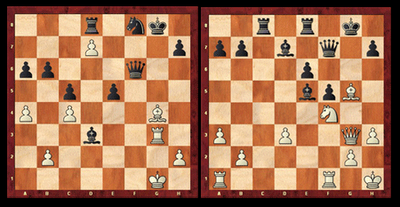Tactical insanity: blitzin' on subpatterns
I am doing 150-300 tactical problems a day. As I've said before, it is intense. Aside from the sheer mental and temporal load it requires, doing hundreds of problems a day is a very different experience than doing 10 or 20 a day. There are a couple major differences I've noticed.
First, I am now pretty much in blitz mode during the tactical training, and this has started to adversely affect my thought process in real games. I am playing impulsively and making stupid mistakes. Quickly solving 300 problems creates an illusion of tactical prowess on my part. I need to consciously remind myself to switch to a lower gear when I get back to standard time controls.
Second, very similar sub-patterns now emerge in the same session, but these sub-patterns contain important differences that require some caution. Since I am now working in blitz mode, it is always tempting to just make the first move that pops into my head, but it is important to check that all the key elements of the memorized pattern are there, not just some of the key elements. For instance, consider the following two positions from Chess Tactics for Beginners (CTB):
 Each position contains the same motif along the g-file, but they exploit this sub-pattern with very different consequences. Even at the second stage (out of five) of exercises, CTB has many such problem-clusters, often three or four problems with the same subpatterns exploited in different ways. This conscious recognition of subpatterns embedded in quite different contexts is something that I hadn't really experienced when doing only 10-20 problems a day. I guess if I were solving the problems by tactical motif, this would have been more obvious.
Each position contains the same motif along the g-file, but they exploit this sub-pattern with very different consequences. Even at the second stage (out of five) of exercises, CTB has many such problem-clusters, often three or four problems with the same subpatterns exploited in different ways. This conscious recognition of subpatterns embedded in quite different contexts is something that I hadn't really experienced when doing only 10-20 problems a day. I guess if I were solving the problems by tactical motif, this would have been more obvious.
First, I am now pretty much in blitz mode during the tactical training, and this has started to adversely affect my thought process in real games. I am playing impulsively and making stupid mistakes. Quickly solving 300 problems creates an illusion of tactical prowess on my part. I need to consciously remind myself to switch to a lower gear when I get back to standard time controls.
Second, very similar sub-patterns now emerge in the same session, but these sub-patterns contain important differences that require some caution. Since I am now working in blitz mode, it is always tempting to just make the first move that pops into my head, but it is important to check that all the key elements of the memorized pattern are there, not just some of the key elements. For instance, consider the following two positions from Chess Tactics for Beginners (CTB):
 Each position contains the same motif along the g-file, but they exploit this sub-pattern with very different consequences. Even at the second stage (out of five) of exercises, CTB has many such problem-clusters, often three or four problems with the same subpatterns exploited in different ways. This conscious recognition of subpatterns embedded in quite different contexts is something that I hadn't really experienced when doing only 10-20 problems a day. I guess if I were solving the problems by tactical motif, this would have been more obvious.
Each position contains the same motif along the g-file, but they exploit this sub-pattern with very different consequences. Even at the second stage (out of five) of exercises, CTB has many such problem-clusters, often three or four problems with the same subpatterns exploited in different ways. This conscious recognition of subpatterns embedded in quite different contexts is something that I hadn't really experienced when doing only 10-20 problems a day. I guess if I were solving the problems by tactical motif, this would have been more obvious.| # Circles | Percent Correct | |
| Problem Set 1 | 14 | 98-99-100-100-100-100-100 100-100-100-99-100-99-98 |
| Problem Set 2 | 14 | 90-93-96-99-99-99-99 99-99-99-99-99-99-99 |
| Problem Set 3 | 0 | |
| Problem Set 4 | 0 | |
| Problem Set 5 | 0 |
NOTE: Circles done with CTB.
3 Comments:
about how much time is this taking (100-300 problems)? altough i started on "easy" problems, i have noticed i either find the answer quickly or not at all.. was it like this for you in the begining?
I think there are sometimes dual danger points calculating too little and calculating too much. I have at times calculated and found a move which looked good on the surface but lost material. After calculated more lines, I forget the original analysis and make the bad move. Tactical training allows one to see more,quicker which is a plus. However it must be tempered with playing carefully and checking and rechecking. Something I need to work on..........
The first time through the problemset, my experience was the same: some problems I couldn't solve in 10 minutes, and I was doing between 5-10 problems a day. Now doing 300 problems takes about an hour and a half (so an average of twenty seconds per problem). The problems I take longer to recognize I hit the forward arrow button and come back to it at the end.
Post a Comment
<< Home